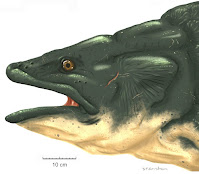 |
| Mawsoniidae gen. et sp. indet. (MJML K785). in Toriño, Gausden, Etches, Rankin, Marshall & Gostling, 2023. (artwork by S. Gausden). |
Abstract
A large mawsoniid coelacanth from the lower part of the marine Kimmeridge Clay Formation of England (Kimmeridgian, Upper Jurassic) is studied here. The material is constituted by a group of bones from the head and shoulder girdle of a considerably large individual (estimated length ca. 1.5 m), including the left angular, left dentary, left prearticular, left palatoquadrate complex, both ceratohyals and right cleithrum. Characters such as the coarse external ornamentation of the angular, and the robustness of the quadrate and the cleithrum allow classification of the individual as a member of the Mawsoniidae; whereas the configuration of external bones of the lower jaw (ornamentation of the angular constituted mainly by longitudinal ridges, the presence of a lateral swelling in the dentary) indicates stronger Gondwanan affinities than previously expected (i.e., with the genus Mawsonia, up to now only recorded in South America by the end of the Jurassic). Considering the above, two alternative evolutionary, paleobiogeographic, and taxonomic scenarios are discussed: (1) the new individual can be referred to the European mawsoniid genus Trachymetopon (Lower–Middle Jurassic), in which case it should be assumed this genus reached the Upper Jurassic, and with a morphological variability higher than previously suspected (including some characters previously assumed as diagnostic for Mawsonia). Or (2) an unknown Mawsonia-like form was present in the Upper Jurassic of Europe. The last scenario puts the identification of isolated elements of European Jurassic giant mawsoniids in a new complex taxonomic and paleobiogeographic context, which will deserve further research.
Pablo Toriño, Shane F. Gausden, Steve Etches, Kathryn Rankin, John E. A. Marshall and Neil J. Gostling. 2023. An enigmatic large mawsoniid coelacanth (Sarcopterygii, Actinistia) from the Upper Jurassic Kimmeridge Clay Formation of England. Journal of Vertebrate Paleontology. 42(1); e2125813. DOI: 10.1080/02724634.2022.2125813






